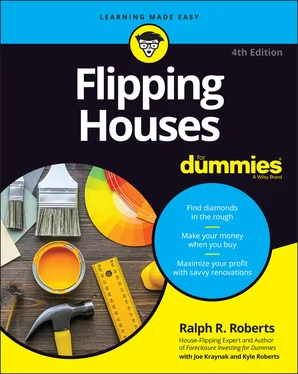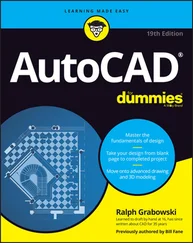Ralph R. Roberts - Flipping Houses For Dummies
Здесь есть возможность читать онлайн «Ralph R. Roberts - Flipping Houses For Dummies» — ознакомительный отрывок электронной книги совершенно бесплатно, а после прочтения отрывка купить полную версию. В некоторых случаях можно слушать аудио, скачать через торрент в формате fb2 и присутствует краткое содержание. Жанр: unrecognised, на английском языке. Описание произведения, (предисловие) а так же отзывы посетителей доступны на портале библиотеки ЛибКат.
- Название:Flipping Houses For Dummies
- Автор:
- Жанр:
- Год:неизвестен
- ISBN:нет данных
- Рейтинг книги:3 / 5. Голосов: 1
-
Избранное:Добавить в избранное
- Отзывы:
-
Ваша оценка:
- 60
- 1
- 2
- 3
- 4
- 5
Flipping Houses For Dummies: краткое содержание, описание и аннотация
Предлагаем к чтению аннотацию, описание, краткое содержание или предисловие (зависит от того, что написал сам автор книги «Flipping Houses For Dummies»). Если вы не нашли необходимую информацию о книге — напишите в комментариях, мы постараемся отыскать её.
Flipping Houses For Dummies
Flipping Houses For Dummies
Flipping Houses For Dummies
Flipping Houses For Dummies — читать онлайн ознакомительный отрывок
Ниже представлен текст книги, разбитый по страницам. Система сохранения места последней прочитанной страницы, позволяет с удобством читать онлайн бесплатно книгу «Flipping Houses For Dummies», без необходимости каждый раз заново искать на чём Вы остановились. Поставьте закладку, и сможете в любой момент перейти на страницу, на которой закончили чтение.
Интервал:
Закладка:
In this section, I guide you through the process of taking inventory of the cash and other valuables you may be able to convert to cash to fund your house flipping venture.
Shaking your piggy bank
Chances are good that you have no actual piggy bank, and if you do, it probably doesn’t have much in it. However, you may have some money stashed away in savings and checking accounts or certificate of deposit (CD) accounts. You may also have savings bonds stuffed in a drawer or a lockbox that people have gifted you over the course of your life. A few of them may have matured. See how much money you can scrounge up from what you already have on hand. It may not be much, but it can help finance repairs and renovations.
 You need to have money to buy and renovate a property and additional funds — at least 5 to 10 percent of your total cost — to prepare for the unexpected, such as a furnace dying in the middle of winter. You may have enough cash stashed to cover the unexpected expenses.
You need to have money to buy and renovate a property and additional funds — at least 5 to 10 percent of your total cost — to prepare for the unexpected, such as a furnace dying in the middle of winter. You may have enough cash stashed to cover the unexpected expenses.
Unleashing the equity of your current home
Your home is more than just a place to live — it’s an investment, perhaps the best-performing investment you have (or the worst, if property values in your area have dropped dramatically). As you pay down the principal on the mortgage, equity in the home grows (assuming that the house appreciates). Equity is your home’s net worth — if you sold the home today and paid off the mortgage, equity is the money you would stuff in your pocket.
You don’t have to sell your home to pocket the equity. By refinancing the home or taking out a home equity loan, you can unleash the equity and use it (or a portion of it) as investment capital to finance your house flipping venture. I cover both these options, along with the risks of unleashing equity in your home, in the following sections. Further on in this chapter, I show you how to work with banks and other lending institutions to unlock the equity in your home.
 You don’t have to tap into the equity in your home to flip houses. Tapping into your equity can place your primary residence at risk, and if you and your spouse both sign the loan documents, you’re both at risk. If you’re uncomfortable placing your home and other possessions at risk, consider borrowing money from a private lender instead; see the later section “ Borrowing from a private (hard money) lender.”
You don’t have to tap into the equity in your home to flip houses. Tapping into your equity can place your primary residence at risk, and if you and your spouse both sign the loan documents, you’re both at risk. If you’re uncomfortable placing your home and other possessions at risk, consider borrowing money from a private lender instead; see the later section “ Borrowing from a private (hard money) lender.”
Recognizing the risks
 In many ways, equity is funny money — or fuzzy money. Nobody really knows how much you can sell your home for until you actually sell it, so borrowing against equity is a bit risky. Before taking the leap, be well aware of the risks:
In many ways, equity is funny money — or fuzzy money. Nobody really knows how much you can sell your home for until you actually sell it, so borrowing against equity is a bit risky. Before taking the leap, be well aware of the risks:
If real estate values drop, you may owe more on your home than it’s worth. If you have to sell it, you’ll end up selling it at a loss.
Unlike some types of loans, mortgage and home equity loans use your home as collateral. If you can’t afford the higher house payments on your new loan, you may lose your home in foreclosure.
If interest rates rise, refinancing at a higher rate or for a longer term results in paying more for your current home — potentially, tens of thousands of dollars more — than if you had kept your old, lower-interest loan.
Frequent refinancing can cost you thousands in closing costs that may take you years to recoup.
Refinancing your mortgage
The easiest way to unlock a chunk of equity is to refinance your home, giving you a whole new mortgage, paying off the old mortgage, and leaving you the rest. Ideally, you refinance a mortgage not only to cash out equity for investment capital but also to snag a lower interest rate or shorter term, so you pay less interest over the life of the loan.
Suppose that you have a $200,000, 30-year mortgage at 8 percent with a monthly house payment of $1,467.53. You’ve owned the house for 10 years and still owe $175,000 on the mortgage. If you refinance for $250,000 (the home’s current appraised value) and take out a 20-year mortgage at 4.5 percent, now you have a house payment of $1,581.62 and you walk away with the $75,000 equity that was locked up in the house (the refinanced amount of $250,000 minus the $175,000 to pay off the old mortgage) to use as investment capital.
Well, that certainly looks rosy, but what have you lost in the transaction?
You now owe $250,000 on your home and have no equity built up in it.
Your new house payment is $114 more than your previous house payment.
Over the life of the loan, you’re scheduled to pay $27,360 more than you would have paid by sticking with your original mortgage.
In short, you’ll pay $27,360 over the course of 20 years to gain access to $75,000 now. But think of it this way — by putting your equity to work for you in successful flips, you may be able to turn that $75,000 into far more than $27,360. In fact, you might make that much money and then some on your first flip!
Of course, you don’t have to unleash all the equity in your home. To build on the previous example, you could take out a 20-year, $225,000 loan at 4.5 percent, with a monthly payment of $1,423.46, freeing up $50,000 in equity, or a 20-year, $200,000 loan at 6 percent with a monthly payment of $1,265.30, freeing up $25,000 in equity. Your choice depends primarily on your comfort level and risk and debt tolerance. The more equity you leave in the house, the greater your cushion, but that also means less investment capital to work with.
 When refinancing, take the following precautions:
When refinancing, take the following precautions:
Don’t refinance into a loan that has a prepayment penalty — a provision in the loan agreement stating that if you pay off the balance of the loan early, you have to pay extra. The amount you’re required to pay is usually a percentage of the balance at the time you pay off the loan or a certain number of months of interest. The purpose of a prepayment penalty is to ensure that the lender receives some compensation for its work.
Don’t refinance a fixed-rate mortgage into a new adjustable-rate mortgage. Adjustable-rate mortgages are unpredictable; you can get burned by a sudden increase in the interest rate and your monthly payments.
Taking out a home equity loan or line of credit
Taking out a home equity loan or line of credit unlocks the equity in your home without affecting your current mortgage:
A home equity loan provides you with a single chunk of money — a one-time payment to you.
A home equity line of credit enables you to borrow only what you need and pay interest on only what you borrow, making this option attractive for financing renovations. It’s sort of like a credit card, often with a higher credit limit and lower interest rate.
 When shopping for a home equity loan or line of credit, look for a lender that doesn’t charge closing costs. Some banks and credit unions even cover the cost of the credit report and appraisal.
When shopping for a home equity loan or line of credit, look for a lender that doesn’t charge closing costs. Some banks and credit unions even cover the cost of the credit report and appraisal.
Интервал:
Закладка:
Похожие книги на «Flipping Houses For Dummies»
Представляем Вашему вниманию похожие книги на «Flipping Houses For Dummies» списком для выбора. Мы отобрали схожую по названию и смыслу литературу в надежде предоставить читателям больше вариантов отыскать новые, интересные, ещё непрочитанные произведения.
Обсуждение, отзывы о книге «Flipping Houses For Dummies» и просто собственные мнения читателей. Оставьте ваши комментарии, напишите, что Вы думаете о произведении, его смысле или главных героях. Укажите что конкретно понравилось, а что нет, и почему Вы так считаете.












